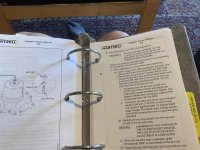Prior to '08, the stop nut was a locking metal nut, which was replaced with a nylon lock nut for better sealing. An optional pitch stop set screw with slightly increased length was introduced at this time as well to account for the additional height of the nylon lock nut. It's possible you've got a tall nut with a short screw, which would limit how high you can set your low pitch. However, even in that case it is still odd that you're out of adjustment.
Was there a lot of wind, and were you pointed into it, for this adjustment? That will give false data for setting pitch.
I'd recommend having the prop shop measure the blade angle you've currently have it set to before it's torn down and ask them, if they don't find any issues, to have it rebuilt to a few degrees higher than that. This should ensure you have adjustment in the range you need it, or identify an issue with trying to do so.


